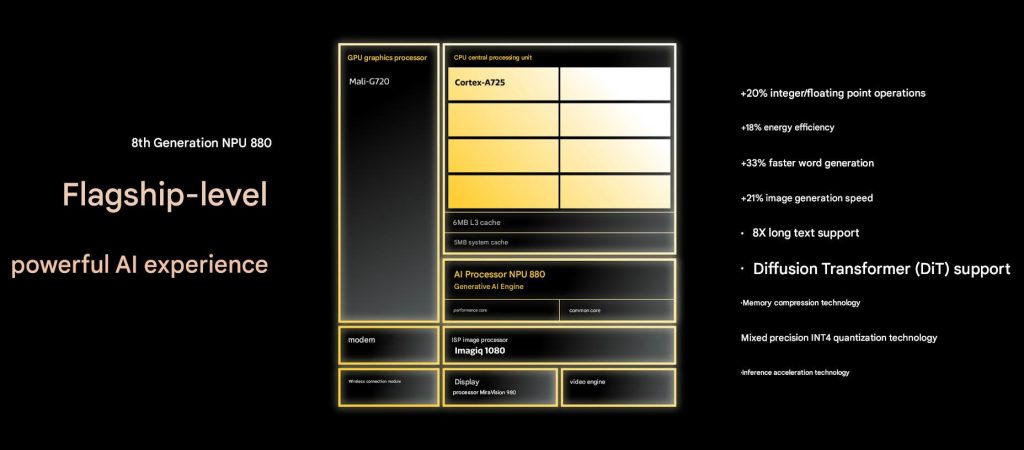
MediaTek just announced the Dimensity 8400 as the successor to last year’s Dimensity 8300 SoC, as it had promised. This brings an All Big Core design to the premium smartphone market for the first time, said the company.
With a powerful NPU for Gen-AI tasks, along with MediaTek’s new Dimensity Agentic AI Engine (DAE) it turns traditional AI applications into sophisticated agentic AI applications, said the company.
CPU and GPU

The Dimensity 8400 SoC has an eight-core Arm Cortex-A725 processor operating at up to 3.25GHz, promising 41% higher multi-core performance compared to Dimensity 8300. It promises 44% reduction in peak power use compared to its predecessor.

The Arm Mali-G720 GPU that promises 24% higher peak performance and 42% greater power efficiency than the Dimensity 8300. The Mali-G720 GPU works in tandem with MediaTek Frame Rate Converter (MFRC), which delivers smoother gameplay, and MediaTek Adaptive Gaming Technology (MAGT) 3.0, which optimizes game and app performance in real-time, said MediaTek.
APU

The MediaTek NPU 880 supports mainstream LLM/SLM/LMMs across the globe and also integrates MediaTek’s DAE, which was introduced with the flagship Dimensity 9400 SoC, enabling developers to create innovative agentic AI applications that anticipate user needs and adapt to their preferences.
ISP

The MediaTek Imagiq 1080 ISP leverages QPD remosaic technology to capture more light, focus faster and more accurately, and produce high-resolution images. The chip also supports HDR recording throughout the entire zoom range.
Connectivity
The 5G-A modem supports up to 3CC-CA and up to 5.17Gbps performance
Network Observation System (NOS) technology for precise 5G/Wi-Fi switching.

MediaTek Dimensity 8400 specifications
- 1x Arm Cortex-A725 at 3.25GHz, 1MB L2, 3x Arm Cortex-A725 at 3.0GHz, 512MB L2, 4x Arm Cortex-A725 at 2.1GHz, 256KB L2
- 6MB L3 + 5MB SLC
- 1.3GHz Arm Mali-G720 MC6 GPU
- MediaTek APU 880 (Generative AI), Up to 10 billion parameters, 18% higher power efficiency, 33% faster text generation (Baichuan 4B), 21% faster in Stable Diffusion v1.5, Diffusion Transformer support, NeuroPilot compression technology, Mixed-precision INT4 quantization technology, Faster LLM speculative speed support
- TSMC’s second generation 4nm process
- 120Hz WQHD+ / 180Hz Full HD+ display support, HDR10+ Adaptive support
- Up to 320MP camera, 3x 32MP, Imagiq 1080 14-bit HDR-ISP
- 3GPP-R16, Sub-6GHz (FR1), 2G-5G multi-mode, 5G-CA, 4G-CA, 5G FDD / TDD, 4G FDD / TDD, TD-SCDMA, WDCDMA, EDGE, GSM
- 5G/4G Dual SIM Dual Active, SA & NSA modes; SA Option2, NSA Option3 / 3a / 3x, NR FR1 TDD+FDD, DSS, 256QAM VoNR / EPS fallback
- GPS L1CA+L5+L1C, BeiDou B1I+ B1C + B2a, Glonass L1OF, Galileo E1 + E5a, QZSS L1CA + L5, NavIC L5
- Wi-Fi 6E (a/b/g/n/ac/ax) ready, 2T2R, Bluetooth 5.4
- Supports LPDDR5X memory up to 8533Mbps,UFS 4 + MCQ
Availability
MediaTek said that the Dimensity 8400 SoC will power 5G devices launching in the market by end of 2024.
Redmi Turbo 4 with Dimensity 8400-Ultra

Xiaomi has confirmed that the Redmi Turbo 4 will be the first phone to use the customized Dimensity 8400-Ultra flagship platform in early 2025.

realme has confirmed Dimensity 8400 Endurance Ares co-creation plan in its upcoming phone, which is said to be Realme Neo7 SE.
